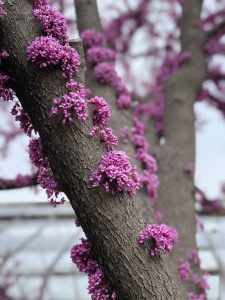
Driving through north Alabama and central Tennessee this week, my eyes were drawn to a stunning display of color on the roadsides. The redbud (Cercis canadensis) trees are a striking shade of fuschia and really pop out in contrast to the bright green of other trees leafing out. Depending on the local weather conditions, some of the trees were covered in pinkish purple buds, while others were overrun with pale pink blossoms.

When you get up close to the trees, they’re remarkable in other ways. The buds sprout directly on the branches and trunk, covering nearly the entire body of the tree, and not just the branch tips. Botanically, this direct branch growth is called “ramiflorous,” (branch-flower in Latin) while the blooms on the main trunk are called “cauliflorous” (stem-flower)! It is a relatively rare occurrence in temperate regions but quite common in the tropics. Theories on the advantage of this type of growth range from ease of pollination for climbing animals (particularly bats), or perhaps a way of reducing competition for nutrient needs between leaves and flowers. Based on an in-depth discussion of redbud cauliflory in the Bulletin of the Virginia Native Plant Society, one botanist postulated that the redbud’s ancestral ties to tropical species could hold the clue. Since it is typically an understory tree, having buds on the trunk allowed easier access for insect pollinators that live closer to the ground, like bumblebees and carpenter bees.

Redbuds grow well throughout the southeast, with a native range from the eastern half of the United States down to the northern reaches of Mexico. That being said, it can grow in almost every state in the union, minus North Dakota and the upper regions of the states bordering Canada (although Ontario can grow them, perhaps the origin of its genus, canadensis). The redbud is the state tree of Oklahoma, where a Mexican variety performs a bit better than the Eastern redbud. In addition to the showy buds and blooms, the redbud has attractive deep green heart-shaped leaves. They grow in the spring after the flowers’ arrival. In the fall, the leaves turn yellow before dropping.

Overall, the redbud can tolerate a wide variety of soil types, sun exposure, and temperatures, contributing to its extensive range. Redbuds grow quickly when young and can reach 20-30 feet at maturity, with a multi-trunked form. Due to their ability to thrive in partial shade, they make great understory trees in landscapes. Redbuds can grow in sand, clay, or loamy soil, and in a variety of pH levels. They are drought tolerant but would not do well in a coastal landscape with salt exposure. The tree can be vulnerable to a few pests, so if you have one keep an eye out for any issues. Fungal cankers can form on branches, grow large enough to encircle and girdle branches. There are no good “cures” for canker, so an affected limb would need to be pruned off.
The redbud is in the pea Family (Fabaceae) and both the flowers and seed pods are edible. I have never tasted them, though, so no promises on flavor!
 7
7
